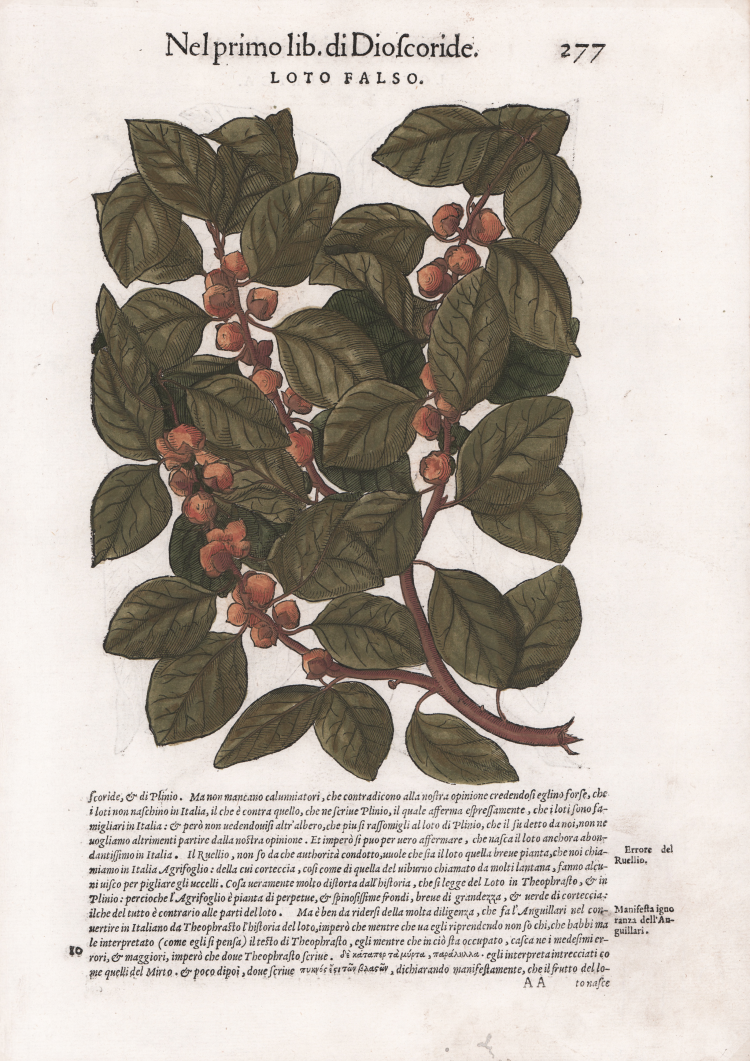



| Reference: | s1266 |
| Author | Pietro Andrea MATTIOLI |
| Year: | 1570 ca. |
| Printed: | Venice |
| Measures: | 240 x 340 mm |


| Reference: | s1266 |
| Author | Pietro Andrea MATTIOLI |
| Year: | 1570 ca. |
| Printed: | Venice |
| Measures: | 240 x 340 mm |
Plate taken from I discorsi di M. Pietro Andrea Matthioli sanese, medico cesareo, et del serenissimo prencipe Ferdinando arcidvca d'Austria & c. Ne i sei Libri di Pedacio Dioscoride Anazarbeo della materia medicinale printed in Venice by Vincenzo Valgrisi.
Mattioli's Italian translation of the works of Dioscorides.
Mattioli (1501-1577) was a Siennese doctor and naturalist. He described more than one hundred new plants and contributed to the development of medical botany. This, his most important work, was first printed in 1544 in Italian, 1554 in Latin, French in 1561, Czech in 1562, and in German in 1563.
The wood cuts in his work were accurate and standardized enough to allow for easy identification. While nominally a commentary on the work of the botanist Dioscordies, Mattioli significantly expanded the work by adding major new contributions. He relied in part on the contributions of the Turkish diplomat, Buscecq, his doctor, Quakelbeen, and the famed botanist, Luca Ghini, who founded the botanical garden in Pisa.
In this work, Mattioli significantly provided the first known observation of a tomato being grown and eaten in Italy.
Woodcut with fine later hand colour, good condition.
Pietro Andrea MATTIOLI (1500 - 1577)
|
Originally from Siena, following the family, he attended medical school at Padua. Exercise his professional career in various Italian places before settling in Trento where he began to learn some botanical studies that will be detailed in subsequent stays, as archiater, Gorizia and Vienna. It is very taken into account and scope, so that the doctor be called the three kings. Immersed in his studies and finished his work day at Trent hit by the plague. Leading scholar of botanical medicine, unable to concentrate in the Commentaries on Dioscorides (first edition 1554) all the herbal knowledge of his time, bringing the number of plants described by Dioscorides from 600 to 1200 and giving each one a description, history and an indication uses and medicinal properties. Also taking into account the lessons of the ancient authors, incorporate new plants imported from the East to the Americas and takes into consideration all the good traditions and pharmacopoeias of the time. The appearance of fitografico iconography, edited by the best engravers of the Italian school and German (Liberal and Meyerbeck) is accurate and useful to the recognition of plants. The "Discourses" will have many issues and will be translated into Italian, French, German and Bohemian. In the field of medicine is remembered for having suggested the use of mercury in the treatment of syphilis being treated in the De ratione gall diseases. Among the major works: Compendium de omnibus PLANTIS ... (1574). De PLANTIS epitome (1586).
|
Pietro Andrea MATTIOLI (1500 - 1577)
|
Originally from Siena, following the family, he attended medical school at Padua. Exercise his professional career in various Italian places before settling in Trento where he began to learn some botanical studies that will be detailed in subsequent stays, as archiater, Gorizia and Vienna. It is very taken into account and scope, so that the doctor be called the three kings. Immersed in his studies and finished his work day at Trent hit by the plague. Leading scholar of botanical medicine, unable to concentrate in the Commentaries on Dioscorides (first edition 1554) all the herbal knowledge of his time, bringing the number of plants described by Dioscorides from 600 to 1200 and giving each one a description, history and an indication uses and medicinal properties. Also taking into account the lessons of the ancient authors, incorporate new plants imported from the East to the Americas and takes into consideration all the good traditions and pharmacopoeias of the time. The appearance of fitografico iconography, edited by the best engravers of the Italian school and German (Liberal and Meyerbeck) is accurate and useful to the recognition of plants. The "Discourses" will have many issues and will be translated into Italian, French, German and Bohemian. In the field of medicine is remembered for having suggested the use of mercury in the treatment of syphilis being treated in the De ratione gall diseases. Among the major works: Compendium de omnibus PLANTIS ... (1574). De PLANTIS epitome (1586).
|